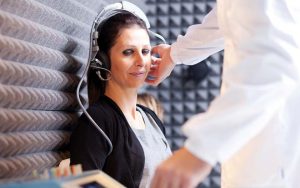Our ability to hear is dependent on tiny hair cells in our inner ears which receive sound and interpret it for our brains to comprehend. These hairs, our sensory receptors, cannot regenerate. Once they are damaged or die, our ability to hear is lessened. We measure sound by the amount of vibrations (or cycles) per second, called “Hertz” (Hz).
Higher frequency sounds vibrate faster and lower sounds slower. Depending on what kind of damage has occurred to the ear’s hair cells determines whether hearing loss is of the higher or lower frequency.
High Frequency
Normal human hearing ranges from 20 Hz to 20,000 Hz (abbreviated 20 kHz), although the range can easily vary from person to person. The higher register is considered any sounds over 2 kHz. And while humans do have the potential to hear up to 20 kHz, simple aging begins to fade the higher register as early as age eight. After age 25, most adults will hear only up to 15 kHz. This is perceived as normal aging, but there are many other factors which can reduce our high frequency hearing even further.
Factors that can reduce our high frequency hearing
Exposure to loud noises over prolonged periods of time is the greatest contributor to high frequency hearing loss. Occupational noise from machinery such as in construction, factories, law enforcement, military and farming damages and ultimately can destroy the delicate hair cells in the ear, causing high frequency hearing loss. Likewise, exposing the ear to loud music whether through amplifiers (at concerts or clubs) or headphones (iPods or other music players) can also cause irreversible damage.
High frequency hearing loss is most noticeable in speech. Higher sounds like “s” and “th” become hard to distinguish. Women’s voices are often more difficult to understand, and speech in general sounds muffled. It becomes harder to hear in noisy areas, and certain sounds will appear noticeably louder than others. The best way to prevent high frequency hearing loss (beyond what is normal for aging) is to protect your ears. Wear ear plugs when being exposed to loud noises, and be sure not to play your music above 80 decibels (60% volume on an iPod).
Low Frequency
Sounds in the low frequency register (under 2 kHz), are sounds such as thunder, a tuba, a large dog’s bark, or a truck rumbling by on the highway. Most humans do not hear low frequency sounds as easily as high frequency sounds, especially the further away we are from the source. For example, in music, sub-woofers are used to specially amplify bass notes, but headphones (directly in our ears) don’t require additional amplification.
When low frequency hearing damage occurs, it is generally caused by disease or heredity. Some people are born with a genetic mutation of the hair cells which limit low frequency hearing. Others may suffer from Meniere’s disease, a rare condition in which the membrane deteriorates over time. In some cases, childhood illnesses or ear infections can lead to low frequency hearing loss.
In most cases of low frequency hearing degradation, the sufferer might not even recognize they have lost the ability to hear lower sounds as many of the same sounds are still supported in the mid to high frequency ranges, thereby still allowing the individual to comprehend the sound. Think of it as someone who can still see by squinting. They don’t see as well as they would with glasses, but they manage.
Prevention of low frequency hearing loss depends on the cause. The best suggestion is to make sure ear infections, especially when they are chronic, are seen by professionals to ensure they do not lead to long-term hearing loss.

Treatment
Whenever hearing loss is due to damaged or dead hair cells, treatment revolves around devices of compensation, since nothing can grow back the cells once they are gone. Hearing aids help create the vibration the hair cells no longer have the ability to do on their own. For high frequency hearing loss, this is usually a very effective solution. Unfortunately, low frequency hearing loss does not benefit the same. Since low frequency noises are often considered “background noises,” or ambient sound, normal hearing aids often end up raising the background noise, impeding normal hearing. Special and often more expensive, hearing aids must be employed to help low frequency hearing loss sufferers.
Although hearing loss is a natural part of aging, it is wise to seek professional evaluation to make sure your hearing is still healthy for your age. Routinely go for a hearing test and see a hearing loss doctor if you notice your hearing has gotten worse.


